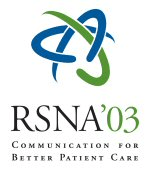
Abstract Archives of the RSNA, 2003
Anesa Ahamad MBBS, PRESENTER: Nothing to Disclose
Abstract:Purpose/Objective: To describe a technique which is useful for delineating tumors of the mucosa of the oral cavity and anterior oropharynx during design of treatment portals for definitive radiotherapy. The administration of a high dose to the primary tumor with a small margin is key to reducing toxicity but can result in geographic misses. CT scanning, while necessary for complex planning techniques and dose calculation, does not necessarily show the extent of mucosal abnormalities especially with superficial spreading tumors. This study presents the applicability, utility and effectiveness of a technique to overcome this limitation of CT and improve localization on lateral simulation films. Materials/Methods: At the Christie Hospital, Manchester, an adhesive radiopaque paste to aid tumor localization has been formulated and utilized for more than 10 years.It is prepared just prior to simulation by combining barium sulfate powder with an adhesive carmellose gelatin paste (ORABASE®). (Approximate ratio of powder:paste is 1:2 by volume or 3:5 by weight). They are mixed to produce a sticky dough. After blotting excess saliva, paste is applied to tumor surface and flattened to cover lesion. Gelatin granules absorb surrounding moisture and become fixed onto the lesion. An intaoral stent may be placed. Simulator images are taken and planning CT scans may be performed. Results: Fluoroscopic images and planning CT scans with paste in situ will be shown for tumors of the inferior and superior alveolus, retromolar trigone, hard palate, soft palate, and floor of mouth. The Figure 1 shows simulator radiographs of the barium in situ with the paste outlined by dotted lines. A: T2 hard palate, B: T2 retromolar trigone, C: T2 soft plate and D: T4 hard palate measuring 4.5cm. Placement of paste is easy to perform. Insertion of oral stents does not dislodge paste and it is well retained without slippage throughout fluoroscopy and scanning as judged by its location relative to tumor following completion of simulation. Radiopaque markers have been traditionally used during simulation for delineating nodes and scars. However marking mucosal lesions usually require invasive implantation of gold seeds because superficially placed markers or water based barium paste become easily displaced. Unlike gold seeds, this technique does not require local anaesthetic, is non-invasive, and requires neither an applicator gun nor elaborate experience. While the seeds remain permanently embedded, the patient may remove the paste after the radiograph is taken. It is more comfortable than seeds for patients since ORABASE® paste is otherwise used to relieve the discomfort of inflamed mucosa. It is well accepted by patients. Conclusions: This documents an efficient, safe, non-invasive, economical method to localize tumors of the oral cavity during simulation. It can help to avoid geographical misses in treating high dose volumes with small margins.
Ahamad MBBS, A,
A Technique to Improve Target Localization of Directly Accessible Head and Neck Tumors. Radiological Society of North America 2003 Scientific Assembly and Annual Meeting, November 30 - December 5, 2003 ,Chicago IL.
http://archive.rsna.org/2003/3242025.html

